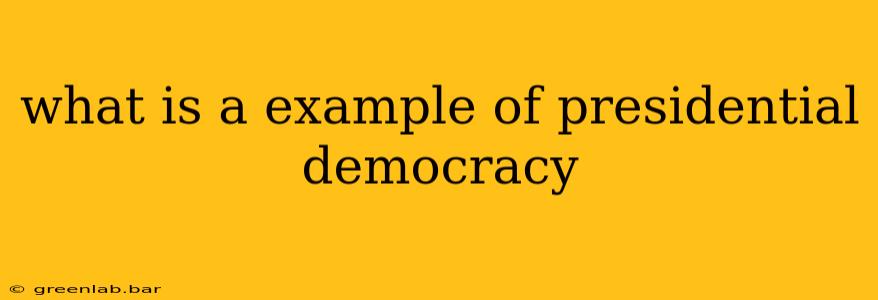A presidential democracy is a system of government where the head of state and head of government are the same person—a president—elected separately from the legislature. This contrasts with parliamentary systems, where the head of government (prime minister) is typically chosen from the legislature. Understanding the nuances of presidential democracies requires examining their key features and then looking at real-world examples.
Key Characteristics of a Presidential Democracy
Before diving into examples, let's clarify the defining features of this governmental structure:
-
Separation of Powers: A core principle is the distinct separation of powers between the executive (president and cabinet), legislative (congress or parliament), and judicial branches. Each branch has its own independent powers and responsibilities, acting as a check on the others to prevent any one branch from becoming too powerful.
-
Fixed Terms: Presidential terms are usually fixed for a specific period (e.g., four or five years), unlike parliamentary systems where the government can be dissolved early. This provides stability but can also lead to situations where a president remains in power despite declining public support.
-
Direct Election: The president is typically elected directly by the people, although the electoral college system in the United States is a notable exception. This direct mandate gives the president significant legitimacy.
-
Independent Executive: The president is not beholden to the legislature for their position. They can appoint their cabinet and pursue their agenda relatively independently, though legislative approval might be needed for certain actions (budgetary matters, for example).
Examples of Presidential Democracies: A Comparative Look
Several countries around the world operate under a presidential democratic system. However, the practical application and effectiveness can vary significantly. Let's examine a few prominent examples:
1. The United States of America:
The US is perhaps the most well-known example. Its system features a strong separation of powers, a directly elected president (albeit via the Electoral College), and a bicameral legislature (Congress). The US system, however, also highlights potential challenges. Gridlock between the executive and legislative branches is not uncommon, and the Electoral College can lead to situations where the popular vote winner does not win the presidency.
2. Brazil:
Brazil offers another example of a presidential democracy, with a president directly elected by popular vote. Brazil's system showcases the potential for both stability and instability. While direct elections provide legitimacy, periods of political turmoil and institutional weakness have also been observed.
3. South Korea:
South Korea presents a case study of a relatively young but robust presidential democracy. Like Brazil, the president is directly elected. However, South Korea’s history of authoritarian rule and subsequent democratic transition highlights the complexities of establishing and maintaining a stable presidential system. Recent political events showcase the ongoing evolution of this system.
4. Mexico:
Mexico’s presidential system demonstrates the evolution of democratic institutions. Following a long period under a dominant party, Mexico’s system has undergone significant changes, leading to a more competitive and diverse political landscape. The country’s experience highlights the ongoing challenges of consolidating democratic norms and practices within a presidential system.
Challenges Faced by Presidential Democracies
While presidential systems offer advantages, they also face significant challenges:
- Potential for Gridlock: The separation of powers can lead to gridlock if the executive and legislative branches are controlled by opposing parties.
- Executive Overreach: A powerful president might attempt to overstep their authority, undermining checks and balances.
- Political Instability: Fixed terms can lead to a president clinging to power despite losing popular support, potentially causing instability.
Conclusion: Diversity Within a System
Presidential democracies, while sharing core features, manifest differently in practice across various countries. Examining specific examples, such as the USA, Brazil, South Korea, and Mexico, reveals both the strengths and weaknesses of this system. Understanding these variations is crucial for appreciating the complexities of governance and the ongoing evolution of democratic institutions worldwide.

